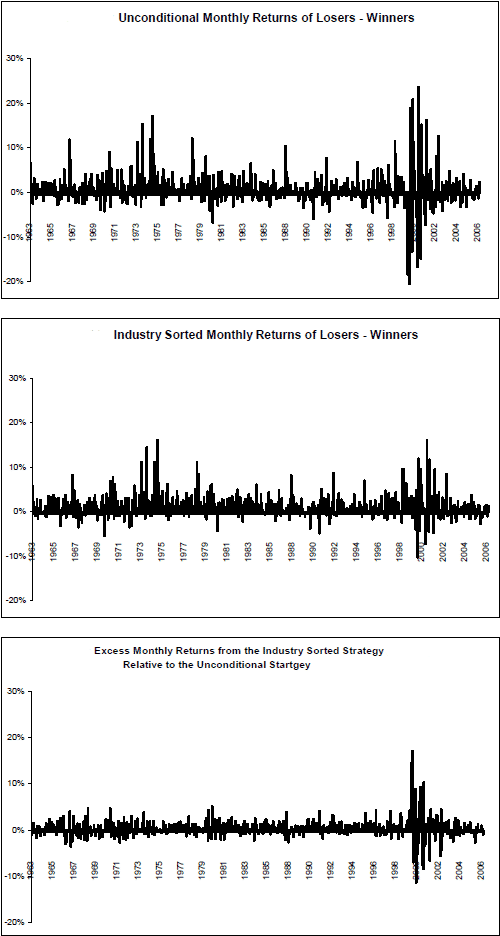Various studies find that returns on individual stocks exhibit tendencies for short-term (one month) reversal, medium-term (3-12 months) momentum and long-term (2-5 years) reversal. The short-term reversal is the basis for the skip-month included in some medium-term momentum strategies. Is there a way to concentrate the short-term reversal? In the March 2010 update of their draft paper entitled “Industries and Stock Return Reversals”, Allaudeen Hameed, Joshua Huang and Mujtaba Mian examine monthly return reversal using stocks grouped into 24 industries, reasoning that such groups share common sources of return correlations. Using return, industry and characteristics data for a broad sample of NYSE/AMEX stocks spanning 1963-2006, they conclude that:
- A hedge strategy that is long (short) the equally weighted fifth of stocks that are the biggest losers (winners) the prior month within each of the 24 industries, reformed monthly and weighting industries equally, generates an average monthly return of 1.46%. A comparable portfolio executed across the total sample of stocks generates an average monthly return of only 1.05%. The standard deviation of monthly reversal returns is 2.9% (4.1%) for the intra-industry (total sample) strategy. (See the charts below.)
- Semiconductors & Semiconductor Equipment (Software & Services) have the largest (smallest) intra-industry average monthly reversal of 3.1% (0.79%).
- Intra-industry reversals are stronger for illiquid, small and highly volatile stocks, suggesting that liquidity risk is an important source of short-run reversals.
- Skipping a week between the one-month formation and holding periods eliminates the the short-term reversal effect for the total sample of stocks, but not for industry groups.
- Stocks that outperform or underperform the total sample but not their industries tend to exhibit momentum rather than reversal. A hedge strategy that capitalizes on both this inter-industry momentum and intra-industry reversals produces a raw (risk-adjusted) average monthly return of 2.3% (2.0%). This strategy produces positive returns for 77% of sample months.
The following charts, taken from the paper, compare month-by-month returns for hedge strategies that are long (short) the equally weighted fifth of stocks that are the biggest losers (winners) the prior month, reformed monthly. The top chart shows returns for this strategy applied across the total sample of stocks (unconditional), while the second shows returns for the strategy applied separately to 24 equally-weighted industries (industry sorted). The third chart shows the differences between the latter and former monthly returns. Results indicate that: (1) reversal returns are persistent over time; (2) intra-industry reversal returns are less volatile than total sample reversal returns; and, (3) intra-industry reversal returns tend to be larger than total market reversal returns.

Return estimates apparently do not account for any trading frictions, which could be substantial.
In summary, evidence suggests that investors can concentrate the short-term (one month) stock return reversal effect by focusing at the industry level.
The role of liquidity risk and the inter-industry momentum effect described above imply that short-term reversal may not be evident in broad, value-weighted market indexes.